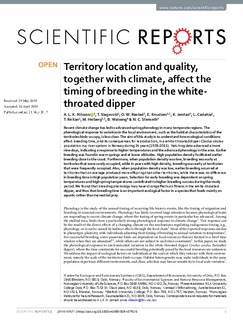| dc.contributor.author | Nilsson, Anna | |
| dc.contributor.author | Slagsvold, Tore | |
| dc.contributor.author | Røstad, Ole Wiggo | |
| dc.contributor.author | Knudsen, E. | |
| dc.contributor.author | Jerstad, Kurt | |
| dc.contributor.author | Cadahia, Luis | |
| dc.contributor.author | Reitan, Trond | |
| dc.contributor.author | Helberg, Morten | |
| dc.contributor.author | Walseng, Bjørn | |
| dc.contributor.author | Stenseth, Nils Christian | |
| dc.date.accessioned | 2019-08-09T12:46:34Z | |
| dc.date.available | 2019-08-09T12:46:34Z | |
| dc.date.created | 2019-06-21T15:44:41Z | |
| dc.date.issued | 2019-05-21 | |
| dc.identifier.citation | Scientific Reports. 2019, 9, 11 | nb_NO |
| dc.identifier.issn | 2045-2322 | |
| dc.identifier.uri | http://hdl.handle.net/11250/2607789 | |
| dc.description.abstract | Recent climate change has led to advanced spring phenology in many temperate regions. The phenological response to variation in the local environment, such as the habitat characteristics of the territories birds occupy, is less clear. The aim of this study is to understand how ecological conditions affect breeding time, and its consequences for reproduction, in a white-throated dipper Cinclus cinclus population in a river system in Norway during 34 years (1978–2011). Hatching date advanced almost nine days, indicating a response to higher temperatures and the advanced phenology in the area. Earlier breeding was found in warm springs and at lower altitudes. High population density facilitated earlier breeding close to the coast. Furthermore, when population density was low, breeding was early at territories that were rarely occupied, while in years with high density, breeding was early at territories that were frequently occupied. Also, when population density was low, earlier breeding occurred at territories that on average produced more offspring than other territories, while there was no difference in breeding time in high population years. Selection for early breeding was dependent on spring temperatures and high spring temperatures contributed to higher breeding success during the study period. We found that breeding phenology may have strong effects on fitness in the white-throated dipper, and thus that breeding time is an important ecological factor in a species that feeds mainly on aquatic rather than terrestrial prey. | nb_NO |
| dc.language.iso | eng | nb_NO |
| dc.publisher | Nature Research (part of Springer Nature) | nb_NO |
| dc.rights | Navngivelse 4.0 Internasjonal | * |
| dc.rights.uri | http://creativecommons.org/licenses/by/4.0/deed.no | * |
| dc.title | Territory location and quality, together with climate, affect the timing of breeding in the whitethroated dipper | nb_NO |
| dc.type | Journal article | nb_NO |
| dc.type | Peer reviewed | nb_NO |
| dc.description.version | publishedVersion | nb_NO |
| dc.subject.nsi | VDP::Zoologiske og botaniske fag: 480 | nb_NO |
| dc.subject.nsi | VDP::Zoology and botany: 480 | nb_NO |
| dc.source.pagenumber | 11 | nb_NO |
| dc.source.volume | 9 | nb_NO |
| dc.source.journal | Scientific Reports | nb_NO |
| dc.identifier.doi | 10.1038/s41598-019-43792-5 | |
| dc.identifier.cristin | 1706894 | |
| dc.relation.project | Norges forskningsråd: 221393 | nb_NO |
| cristin.unitcode | 224,30,0,0 | |
| cristin.unitname | Avdeling for lærerutdanning | |
| cristin.ispublished | true | |
| cristin.fulltext | original | |
| cristin.qualitycode | 1 | |

